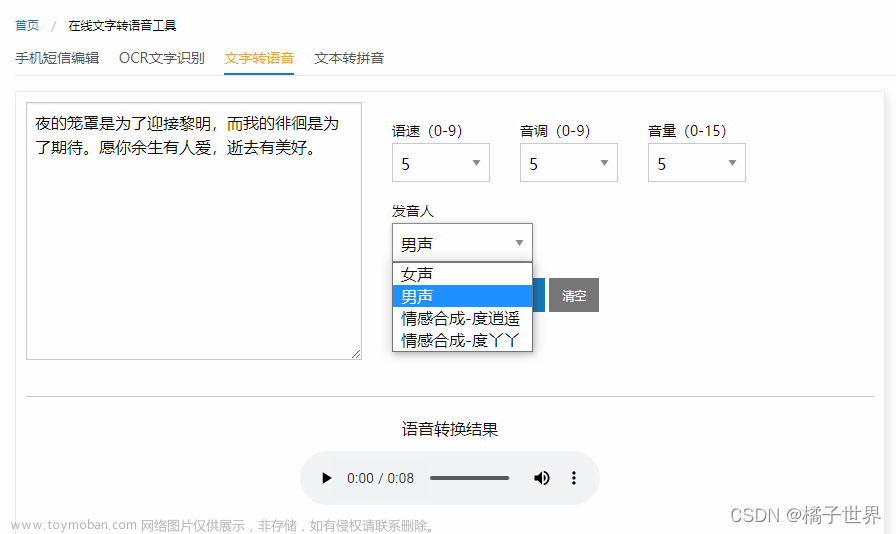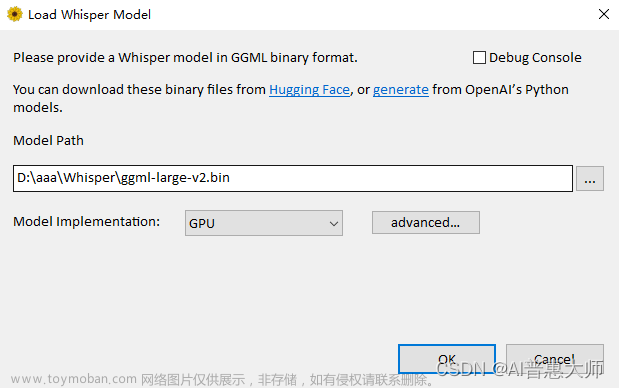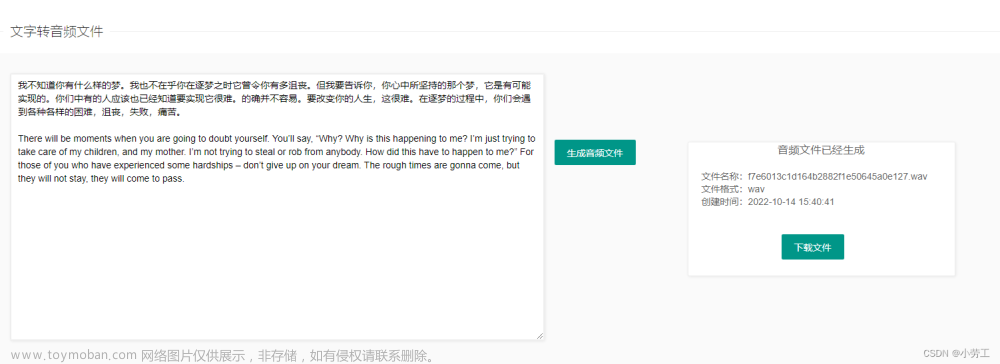前面有一篇博客说到了讯飞输入法,支持语音输入,也支持电脑内部音源输入,详细参考:【实时语音转文本】PC端实时语音转文本(麦克风外音&系统内部音源)
但是它只是作为一个工具来使用,如果我们想自己做一些好玩的东西,比如通过语音来控制电脑做一些自动化的操作等,我们先要收集语音转换为文本,然后再通过解析文本来操作平台,那我们就需要获取到语音识别的内容,通过讯飞输入法这种就不能办到了,这时候我们需要使用API来处理,通过对比国内外一些大厂的智能语音API,发现还是Google的API更加【智能】,更加【听得懂人话】。
说明:因为是使用了Google的API,所以需要具备一定的网络环境,需要能访问Google。
准备工作
官方文档:Cloud Speech-to-Text>文档>准备工作
根据官方文档一步步设置就行了,这里简单说明以下流程:
- 设置Google Cloud 项目
- 确保有一个结算账号关联到该项目
- 启用 Speech-to-Text API
- 创建新的服务账号
- 创建JSON密钥
- 设置身份验证环境变量
语音文件转文本Python示例
准备python环境安装依赖:
- google-cloud-speech==2.16.2
- pyaudio==0.2.12
- six==1.16.0
if __name__ == "__main__":
# Imports the Google Cloud client library
from google.cloud import speech
import os
os.environ["http_proxy"] = "http://127.0.0.1:7890"
os.environ["https_proxy"] = "http://127.0.0.1:7890"
os.environ['GOOGLE_APPLICATION_CREDENTIALS'] = "xxxxx.json"
# Instantiates a client
client = speech.SpeechClient()
# The name of the audio file to transcribe
gcs_uri = "gs://cloud-samples-data/speech/brooklyn_bridge.raw"
audio = speech.RecognitionAudio(uri=gcs_uri)
config = speech.RecognitionConfig(
encoding=speech.RecognitionConfig.AudioEncoding.LINEAR16,
sample_rate_hertz=16000,
language_code="en-US",
)
# Detects speech in the audio file
response = client.recognize(config=config, audio=audio)
for result in response.results:
print("Transcript: {}".format(result.alternatives[0].transcript))
控制台输出:
麦克风语音转文本Python示例
准备python环境安装依赖:
- google-cloud-speech==2.16.2
- pyaudio==0.2.12
- six==1.16.0
#!/usr/bin/env python
from __future__ import division
import re
import sys
from google.cloud import speech
import pyaudio
from six.moves import queue
import os
os.environ["http_proxy"] = "http://127.0.0.1:7890"
os.environ["https_proxy"] = "http://127.0.0.1:7890"
os.environ['GOOGLE_APPLICATION_CREDENTIALS'] = "xxxx.json"
# Audio recording parameters
RATE = 16000
CHUNK = int(RATE / 10) # 100ms
class MicrophoneStream(object):
"""Opens a recording stream as a generator yielding the audio chunks."""
def __init__(self, rate, chunk):
self._rate = rate
self._chunk = chunk
# Create a thread-safe buffer of audio data
self._buff = queue.Queue()
self.closed = True
def __enter__(self):
self._audio_interface = pyaudio.PyAudio()
self._audio_stream = self._audio_interface.open(
format=pyaudio.paInt16,
# The API currently only supports 1-channel (mono) audio
# https://goo.gl/z757pE
channels=1,
rate=self._rate,
input=True,
frames_per_buffer=self._chunk,
# Run the audio stream asynchronously to fill the buffer object.
# This is necessary so that the input device's buffer doesn't
# overflow while the calling thread makes network requests, etc.
stream_callback=self._fill_buffer,
)
self.closed = False
return self
def __exit__(self, type, value, traceback):
self._audio_stream.stop_stream()
self._audio_stream.close()
self.closed = True
# Signal the generator to terminate so that the client's
# streaming_recognize method will not block the process termination.
self._buff.put(None)
self._audio_interface.terminate()
def _fill_buffer(self, in_data, frame_count, time_info, status_flags):
"""Continuously collect data from the audio stream, into the buffer."""
self._buff.put(in_data)
return None, pyaudio.paContinue
def generator(self):
while not self.closed:
# Use a blocking get() to ensure there's at least one chunk of
# data, and stop iteration if the chunk is None, indicating the
# end of the audio stream.
chunk = self._buff.get()
if chunk is None:
return
data = [chunk]
# Now consume whatever other data's still buffered.
while True:
try:
chunk = self._buff.get(block=False)
if chunk is None:
return
data.append(chunk)
except queue.Empty:
break
yield b"".join(data)
def listen_print_loop(responses):
"""Iterates through server responses and prints them.
The responses passed is a generator that will block until a response
is provided by the server.
Each response may contain multiple results, and each result may contain
multiple alternatives; for details, see https://goo.gl/tjCPAU. Here we
print only the transcription for the top alternative of the top result.
In this case, responses are provided for interim results as well. If the
response is an interim one, print a line feed at the end of it, to allow
the next result to overwrite it, until the response is a final one. For the
final one, print a newline to preserve the finalized transcription.
"""
num_chars_printed = 0
for response in responses:
if not response.results:
continue
# The `results` list is consecutive. For streaming, we only care about
# the first result being considered, since once it's `is_final`, it
# moves on to considering the next utterance.
result = response.results[0]
if not result.alternatives:
continue
# Display the transcription of the top alternative.
transcript = result.alternatives[0].transcript
# Display interim results, but with a carriage return at the end of the
# line, so subsequent lines will overwrite them.
#
# If the previous result was longer than this one, we need to print
# some extra spaces to overwrite the previous result
overwrite_chars = " " * (num_chars_printed - len(transcript))
if not result.is_final:
sys.stdout.write(transcript + overwrite_chars + "\r")
sys.stdout.flush()
num_chars_printed = len(transcript)
else:
print(transcript + overwrite_chars)
# Exit recognition if any of the transcribed phrases could be
# one of our keywords.
if re.search(r"\b(exit|quit)\b", transcript, re.I):
print("Exiting..")
break
num_chars_printed = 0
def main():
# See http://g.co/cloud/speech/docs/languages
# for a list of supported languages.
language_code = "zh" # a BCP-47 language tag
client = speech.SpeechClient()
config = speech.RecognitionConfig(
encoding=speech.RecognitionConfig.AudioEncoding.LINEAR16,
sample_rate_hertz=RATE,
language_code=language_code,
)
streaming_config = speech.StreamingRecognitionConfig(
config=config, interim_results=True
)
with MicrophoneStream(RATE, CHUNK) as stream:
audio_generator = stream.generator()
requests = (
speech.StreamingRecognizeRequest(audio_content=content)
for content in audio_generator
)
responses = client.streaming_recognize(streaming_config, requests)
# Now, put the transcription responses to use.
listen_print_loop(responses)
if __name__ == "__main__":
main()
通过麦克风语音会实时转为文本输出,如果需要再对结果进行处理,可以在listen_print_loop方法中修改。
以上代码是在官网的示例基础上做了修改:
- 设置代理(国内需要设置
http_proxy代理,否则无法访问到google api) - 设置环境变量
GOOGLE_APPLICATION_CREDENTIALS,正常情况是在客户端系统设置里设置,这里测试可以直接用代码设置环境变量,这个参数就是准备工作中的JSON密钥文件 - 设置语言language_code为中文zh,官方支持的语言列表:Speech-to-Text 支持的语言
其他官方示例
Google Cloud 官方示例
Speech-to-Text 示例文章来源:https://www.toymoban.com/news/detail-783773.html
电脑内部语音
同样可以将麦克风设置为系统音源,这样就可以实时将电脑内的视频、语音转为文本,做个实时字幕工具也是不错的。具体操作方法参考【实时语音转文本】PC端实时语音转文本(麦克风外音&系统内部音源),只需要做一点点设置就行了。文章来源地址https://www.toymoban.com/news/detail-783773.html
到了这里,关于【Google语音转文字】Speech to Text 超级好用的语音转文本API的文章就介绍完了。如果您还想了解更多内容,请在右上角搜索TOY模板网以前的文章或继续浏览下面的相关文章,希望大家以后多多支持TOY模板网!













